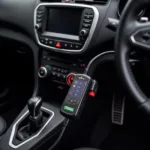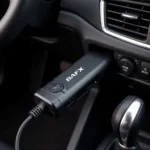The implementation of Euro 5 emission standards significantly impacted the automotive industry, demanding stricter controls on exhaust gases from vehicles sold in Europe. This article delves into the world of OBD2 Euro 5, exploring its significance in modern European vehicles and how it aids in emissions control and diagnostics.
The Evolution of Emission Standards: Why Euro 5 Matters
The Euro 5 emission standard, introduced in 2009, marked a significant step towards cleaner air in Europe. It imposed stringent limits on harmful pollutants emitted by vehicles, including nitrogen oxides (NOx), hydrocarbons (HC), carbon monoxide (CO), and particulate matter (PM). This standard forced car manufacturers to develop sophisticated engine management and exhaust treatment systems, leading to advancements in catalytic converters, diesel particulate filters (DPFs), and exhaust gas recirculation (EGR) systems.
The Role of OBD2 in Euro 5 Compliance
On-board diagnostics II (OBD2) plays a crucial role in ensuring compliance with Euro 5 standards. It acts as a vehicle’s self-diagnostic system, constantly monitoring the performance of emission-related components. By connecting an OBD2 scanner to a vehicle’s OBD2 port, mechanics and car owners can access a wealth of information about the engine, transmission, and emission control systems.
OBD2 scanners can read:
- Diagnostic Trouble Codes (DTCs): These codes pinpoint specific malfunctions within the emission control system, enabling quicker and more accurate repairs.
- Live Data Streams: Real-time information about engine parameters such as oxygen sensor readings, air/fuel ratio, and exhaust gas temperature allows for in-depth analysis of the engine’s performance and efficiency.
- Readiness Monitors: These indicate the status of the vehicle’s various emission control systems, ensuring they are functioning correctly.
Common OBD2 Euro 5 Fault Codes and Their Implications
Euro 5 compliant vehicles are susceptible to specific fault codes related to their advanced emission control systems. Understanding these codes can be invaluable for vehicle owners and mechanics alike:
- P0420 Catalyst System Efficiency Below Threshold (Bank 1): This code often signals a failing catalytic converter, a critical component in reducing harmful emissions.
- P0401 Exhaust Gas Recirculation Flow Insufficient Detected: This code points to a problem with the EGR system, which recirculates exhaust gases to reduce NOx emissions.
- P2002 Diesel Particulate Filter Efficiency Below Threshold (Bank 1): Common in diesel vehicles, this code indicates a problem with the DPF, responsible for trapping soot from the exhaust.
Choosing the Right OBD2 Scanner for Euro 5 Vehicles
With a plethora of OBD2 scanners available, selecting the right one for Euro 5 vehicles can seem daunting. Here are some factors to consider:
- Protocol Compatibility: Ensure the scanner supports the ISO 15765-4 (CAN) protocol, commonly used in Euro 5 vehicles.
- Advanced Functionality: Opt for scanners that can read and clear Euro 5 specific fault codes, perform live data analysis of emission-related parameters, and reset service lights.
- User Friendliness: Consider factors like screen size, interface intuitiveness, and data presentation for ease of use.
[innova obd2 code reader 3011]
[foxwell nt510 obd2 scanner]
The Future of OBD and Emissions Control
As emission regulations continue to evolve with standards like Euro 6 and beyond, the role of OBD in vehicle diagnostics and emissions control will only become more significant. Future OBD systems are expected to incorporate advanced features like:
- Remote Diagnostics: Enabling real-time monitoring of vehicle emissions data by regulatory bodies.
- Predictive Maintenance: Analyzing driving patterns and component wear to predict potential emission-related issues before they arise.
Conclusion
Understanding OBD2 Euro 5 is crucial for anyone involved in the maintenance, repair, or ownership of modern European vehicles. By providing a window into the intricate workings of emission control systems, OBD2 empowers us to diagnose issues accurately and ensure our vehicles contribute to a cleaner environment. Investing in a reliable OBD2 scanner and understanding the information it provides is a proactive step towards responsible vehicle ownership in an increasingly environmentally conscious world.
FAQ
1. Can I use any OBD2 scanner on a Euro 5 vehicle?
While most OBD2 scanners can communicate with Euro 5 vehicles, not all offer the same level of functionality. For comprehensive diagnostics and to access Euro 5 specific codes, it’s recommended to choose a scanner specifically designed for these vehicles.
2. What should I do if my OBD2 scanner detects a fault code?
Further diagnosis is necessary. While the code provides a starting point, it doesn’t always pinpoint the exact cause. Consult a qualified mechanic or refer to your vehicle’s service manual for detailed troubleshooting steps.
3. How often should I check my Euro 5 vehicle for fault codes?
Regular checks are recommended. As a preventative measure, scanning your vehicle for fault codes at least once every few months or before long journeys can help identify potential issues early on.
4. Does resetting the fault codes fix the underlying issue?
No. Resetting or clearing fault codes only temporarily removes them from the vehicle’s memory. If the underlying problem persists, the code will reappear.
5. Can I perform repairs based solely on OBD2 fault codes?
While OBD2 codes provide valuable clues, they shouldn’t be the sole basis for repairs. Thorough diagnosis involving visual inspections, component testing, and professional expertise is crucial for accurate repairs.
Need assistance with your OBD2 needs or have more questions? Reach out to our expert team via WhatsApp: +1(641)206-8880 or Email: [email protected]. We offer 24/7 customer support.
Looking for more information on OBD2 scanners and their applications? Explore our other informative articles on [bluetooth obd2 programming software android] and [european obd2 scanner] for valuable insights.

